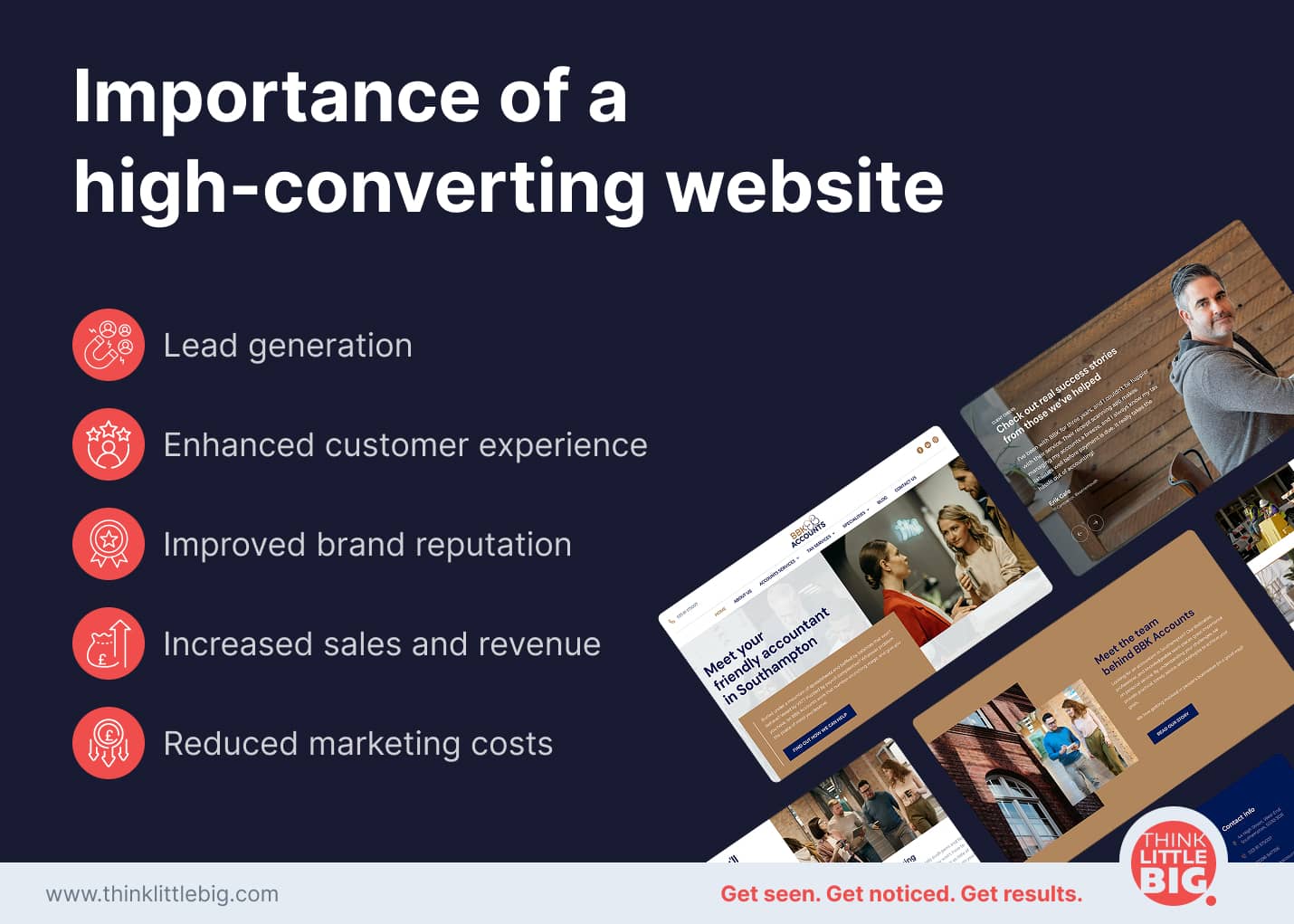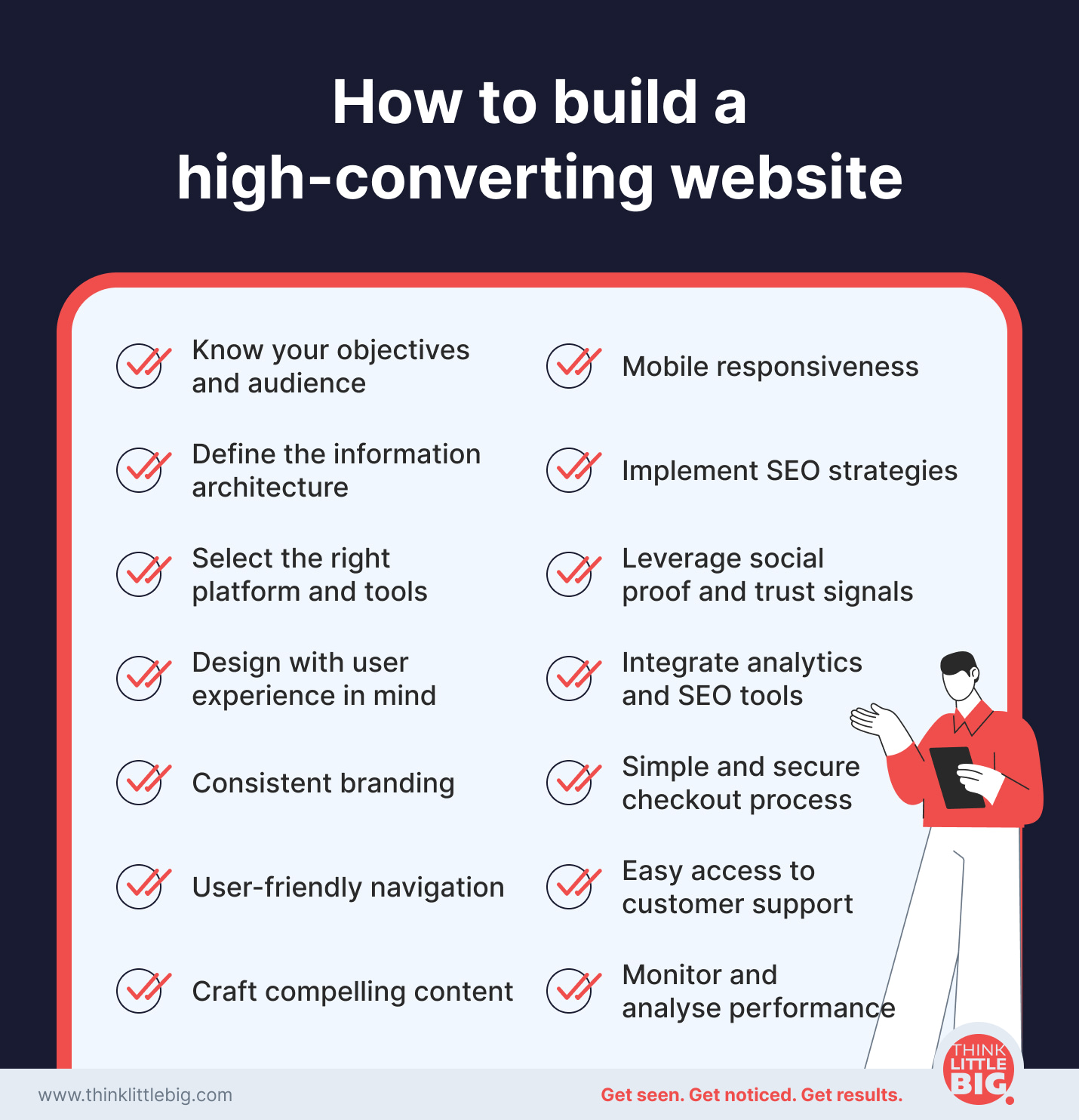In today’s fast-moving world, having a high-converting website is no longer a luxury for small businesses; it is essential. According to Forbes, it takes just .05 seconds for someone to form an opinion about a website – that is not very long to grab someone’s attention.
Your website is a crucial asset that can significantly influence your business’s success. It functions as a digital storefront and often represents your potential customers’ initial interaction arena. This means it has to work from the outset.
Simply having a website for your small business will not solve the purpose; it should be built to attract target audiences, generate leads, and ultimately drive sales. Creating a website is theoretically simple, but as an entrepreneur, you might wonder how to build a website for your small business that generates leads.
Your wait is over. This blog will explore a step-by-step guide to building affordable websites for small businesses that convert visitors to loyal customers. We will delve deep into best practices, advantages, and key strategies to build a high-converting website that stands out amongst your competitors, making the process feel manageable and achievable.
Importance of a high-converting website
The advantages of a high-converting website for a small business go beyond converting visitors. It acts as a digital gateway to the business’s success. Conversion rate refers to the percentage of website visitors who purchase products, subscribe to your newsletters, contact your business, fill out the query form, or, in some way, make that first move to become a customer. Below are the advantages of a high-converting website for small businesses.
1. Lead generation
A well-crafted website design for small businesses will attract potential target customers and convert them into leads. The website should contain details about your brand and showcase your products in a way that solves customers’ problems. This makes it more likely that new website visitors will provide their information in exchange for tangible rewards or for making a purchase.
2. Enhanced customer experience
Understanding your website’s user behaviour will help you curate personalised marketing strategies that enhance customer experience. A well-optimised website will offer all the details target audiences need regarding website navigation, product details, customer support, return or exchange policies, etc., so they become paying customers.
3. Improved brand reputation
You can quickly improve your brand reputation if you know how to build a website that converts leads for your small business. A good website design will contain elements that provide a quality and enjoyable user experience, easy navigation, testimonials and user reviews for social proof, and responsive design that positively impacts customers’ minds.
4. Increased sales and revenue
Imagine your website as a brick-and-mortar store. Plan your site so you can showcase your products in a way that makes them easy for customers to find. Consider store layouts and how they work to make the store easy to navigate.
Similarly, websites need to be professionally designed so that the user experience is simple and visitors can navigate seamlessly. High-quality content, relevant product information, informative blog posts, and strong CTAs help nurture leads, finally increasing sales and revenue.
5. Reduced marketing costs
A well-optimised website can act as a powerful lead-generation machine while reducing your reliance on other paid marketing activities. Search engine optimisation helps your website gain organic traffic and rank higher on search engine results pages (SERPs).
A professional website with engaging quality content also keeps visitors interested in your site. It attracts exemplary visitors, thus reducing the number of uninterested visitors (people who come to your site but leave immediately). On the contrary, it helps convert visitors to leads without relying on other paid marketing efforts.
Stay in the know
Keep on top of how the latest marketing, SEO, branding and design tips can be used to
grow your business – delivered straight to your inbox.
Step-by-step guide: How to build a high-converting website
Whether you are a new entrepreneur, still trying to find your hold, or an established small business owner needing a refresher, let’s throw some light on how to build a website for small businesses for lead generation. Let’s get started.
1. Know your objectives and audience
Your website can’t convert leads without a clear objective. It needs a purpose—what exactly do you want to showcase for your visitors? What goals do you have for your customers? Do you want them to purchase a product or sign up for a trial?
Do you want to increase brand awareness, drive sales, or attract customers? Understanding the goals and objectives helps you to prioritise the website’s attributes, design elements, and content.
Understanding your target audience is a powerful tool in your website-building arsenal. By creating a profile for your ideal customers based on their attributes, behaviours, needs, pain points, and expectations, you can tailor your website’s messaging to resonate with them, giving you a sense of control over your website’s effectiveness.
2. Define the information architecture
Over 38% of users leave a website if the layout or content is not helpful and easy to navigate. Think of your information architecture as the blueprint for your website. It will help you structure your website design and content placement in a way that is intuitive, logical, and easy to navigate for visitors.
Create the website in a way so that every piece of information is placed in the right place to attract customers. Consider making a sitemap before you start designing the website. A sitemap is a visual representation of the hierarchy of your web pages. It will help search engines crawl and index your website, increasing your rank on search engines and providing a clear roadmap to website visitors.
Navigation planning is another crucial aspect of building a high-converting website. The navigation menu of your website should be clear, concise, and self-explanatory, guiding visitors to the information they need without overwhelming them. Use clear labels and a logical structure, and consider the number of categories and sub-categories to ensure a smooth navigation experience.
3. Select the right platform and tools
Depending on the nature of your website, availability of technical support, and budget, you should select the right website-building platform. These platforms come in various options. If you do not have the budget to use an external agency, then platforms such as Wix or Squarespace can be an easy-to-use tool if you are a beginner. These website-building platforms enable visually appealing websites by simply dragging and dropping elements. Remember to be critical and ask for other’s input though.
Alternatively, if you are comfortable coding, a content management system like WordPress is a good option with better flexibility and customisation options. With WordPress, you can build complex websites that require custom integrations, themes, and applications.
If you want to build an e-commerce website for your business, consider features like secure payment gateways, shopping carts, inventory management, etc. Shopify is an excellent platform for this.
4. Design with user experience in mind
As per HubSpot, over 47% of website visitors check out a company’s product page before visiting other sections. User experience (UX) means how a website visitor interacts with your website. A good user experience is a must for a website, as it keeps customers engaged and boosts conversion rates.
Now come the elements of a good user experience: visual appeal, fast loading speed, clarity and readability, and effective placement of calls to action.
Use high-quality visuals, clean layouts, and consistent design elements to make your website visually appealing. Also, write your content precisely and directly throughout your website.
Use consistent font styles, headings, subheadings, and pointers to improve readability. Ensure your website is fast-loading across mobile, PC, and tablet devices.
Design clear and visually appealing CTAs on your website. Use persuasive language and attractive colours that grab the users’ attention and compel them to take action.
5. Consistent branding
Your brand showcases your small business’s overall perception and image. Maintaining a consistent brand across your website and social media will eventually strengthen your brand identity.
Consistent branding can be kept in terms of imagery, visual elements, and messaging, that will foster trust with your customers. Customers can relate to your brand if the brand messaging and branding elements are the same across different platforms.
Now, you would be thinking about how to achieve this. Select fonts and colour palettes that reflect your brand personality and use them across your website. Also, maintain a consistent style for the graphics and images used on the website to create a cohesive customer experience. Do not forget to use consistent brand messaging across your website, as this will strengthen brand recognition and develop a sense of trust among your customers.
6. User-friendly navigation
Upon arriving at a company’s website, 50% of visitors use the navigation menu for guidance. Your website content might be unique, but it will only provide value when it has intuitive navigation. If your target audience finds it difficult to navigate your website, they will most likely go to another site.
A website’s navigation depends on how you design the menu bar and place the internal links. Include a clear and explanatory navigation on your website so that it can guide visitors to find the information they are looking for.
Include the crucial pages of your website in the navigation menu; the less important pages can be interlinked with the content. Use concise and clear labels in the navigation menu, and do not forget to add a search bar on the website for your visitors. It will help your visitors find what they want from your brand.
7. Craft compelling content
Creating high-quality, easy-to-understand content that covers your potential customers’ pain points and needs is the key to converting them into leads. Content should be engaging and provide value to your potential customers.
If the content doesn’t align with your customers’ needs and expectations, you will not get any leads. Instead of writing content for everyone, defining your target customers and writing content that resonates with them will yield results. It should be compelling enough to create value for your products and services in the customer’s mind.
To keep your customers engaged, include different content formats, such as detailed product pages, proper placement of calls to action in web pages, informative blog posts, and problem-solving content, to make your company stand out.
8. Mobile responsiveness
Over 57% of internet users will not recommend any business with a poorly designed website that has difficulty opening on mobiles. With the increasing number of mobile users, it is essential to make sure that your high-converting website design is fully responsive.
Users want a fast-loading website, which increases search engine rankings and enhances customer experience. It will increase your leads and improve the possibilities of word-of-mouth marketing. Ensure your website is fast-loading across mobile, PC, and tablet devices.
9. Implement SEO strategies
Search engine optimisation strategies are essential website conversion strategies that increase your website’s ranking and visibility on search engines. When your website ranks higher on search engines like Google, you will most likely attract organic traffic, leading to higher conversion rates.
SEO strategies include identifying relevant phrases and keywords your target customers seek. You should also optimise your website content with appropriate keyword placement, including CTAs, organically and improve the readability of your content.
10. Leverage social proof and trust signals
Social proofs are user-generated content that boosts brand credibility among your target audience. Over 84% of customers trust online reviews to make their purchasing decisions.
Beyond a detailed, high-converting website, you need your target audience to trust your brand and product offerings. To achieve that, add positive customer reviews and testimonials to your website to portray your product’s quality and to demonstrate how you have fulfilled customer expectations.
Integrate your brand’s social media profiles into your website to increase brand reach and gain customer trust. Today’s audience is more active on social media, they will check your brand presence on social media before purchasing from your website. Integrating social sharing options into your website can encourage visitors to share your content on social media, enabling more brand loyalty.
11. Integrate analytics and SEO tools
Implementing SEO strategies is not enough to build a high-converting website. You need to know how your website performs, how your visitors navigate it, and how they interact with it. SEO analytical tools rescue this situation, measuring your strategies’ performance and identifying improvement areas.
At the most basic level, analytics tools like Google Analytics are vital to understand what is happening with your website – what is and isn’t working, visitor numbers and so on. Once you get a feel for it, you can work with tools such as the Google Search Console, ahrefs, and SEMrush to measure website traffic, conversion rates, user behaviour, organic traffic, keyword rankings, and competitor analysis. With this information and data you can improve your website ranking and gain online visibility, generating more leads.
12. Simple and secure checkout process
Be it an e-commerce or a B2B website, the checkout process is crucial for building a high-converting website. A seamless customer experience throughout the website, especially during checkout, is vital as customers purchase your products and services.
Make the checkout process simple so customers don’t face payment issues. Add different payment options so that customers can choose according to their convenience.
Consider removing the signup options for new visitors before paying, as it takes time and may frustrate customers. Since you do not want to lose sales and customer base, simplify the signup process and create an option for guest buyers.
Also, remember to add security protocols for the transactions; check the relevant security standards to see if your website’s checkout page has met all security requirements.
13. Easy access to customer support
In the omnichannel customer service age, brands compete to serve customers in their preferred channels. As a small business owner, you need to ensure seamless customer support for your target audience to build a high-converting website. Offering excellent customer service enhances user experience and builds brand loyalty.
You can offer various contact options on your brand’s social media channels, such as email, phone, WhatsApp and live chat. It allows your customers to select their preferred channels to reach you. The next step is to set things up so you can promptly respond to customer queries and demonstrate your brand commitment to customer satisfaction.
Another way to increase your website’s customer experience is to create a knowledge base including FAQs and self-help resource sections, such as guides, product demos, user manuals, etc., to address common questions.
14. Monitor and analyse performance
Implementing the above strategies is essential for building a website for your small business, but monitoring and analysing your website’s performance is more critical. Just because your small business website is up and running doesn’t mean your job is done. Regular evaluation and review of what is working and what isn’t is the key to building a high-quality website.
The analytics tools mentioned above allow you to track key metrics such as page traffic, user behaviour, website traffic, keyword performance, and conversion rates. You can also run A/B testing on your website to check which versions of particular web pages are working.
It will help you create a strategy checklist that works for your target audience. Gathering customer feedback is also a critical website conversion optimisation strategy that will reveal the likes and dislikes of your target customers regarding your brand and product offerings.
Optimising your homepage for conversions
The homepage of your website is a digital storefront for your small business. It is the most crucial part of your website, the first page visitors see when they open it. Hence, it is essential to optimise the homepage to encourage your target audience to make purchases, subscribe to your newsletter, or contact your business.
To make your homepage the highest-converting part of your website, you need to include your business’s unique selling proposition of your products. More than 30% to 40% of the traffic on your website comes from your homepage. It has the highest number of pages linked to your website.
It should be optimised so your target audience finds all the relevant information and makes purchase decisions. Optimise your homepage by adding an intuitive navigation style, decluttered fresh page look, high-quality content, visuals, CTAs that grab attention, a search bar, clear and concise headlines, value propositions, and social proofs to increase brand credibility.
Conclusion
While initially generating leads from your website may seem challenging, you can drive traffic if you know how to build a website for small businesses. Building a high-converting website might sound daunting; it requires a strategic approach, including practical design, compelling content, and technical SEO optimisation. Following the steps mentioned in the blog can generate leads and boost sales, customer experience, brand loyalty, brand value, etc.
Remember to regularly monitor your website’s performance and stay up-to-date with the latest website design and development trends. Gather customer feedback through reviews, surveys, feedback calls, etc., and try to incorporate those observations into your website. You can build a website that converts for your small business with continuous effort and optimisation techniques.
Still unsure about how to design your website that generate leads? We at Think Little Big understand the pain points of small businesses and help them build high-converting websites that drive sales. Book a free consultation with us to learn how we help small enterprises achieve their online goals. By leveraging the power of design, content, SEO and development, we launch incredibly high-quality, results-oriented websites for our clients.






